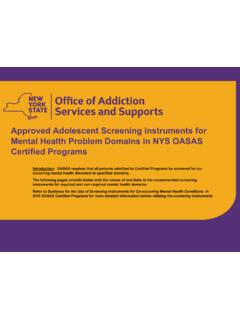Transcription of Stress, Social Support, and the Buffering Hypothesis
1 Psychologkal Bulletin1985, Vol. 98. No. 2, 31 Copyright 1985 by the American Psychological Association, $ , Social Support, and the Buffering HypothesisSheldon CohenCarnegie-Mellon UniversityThomas Ashby WillsCornell University Medical CollegeThe purpose of this article is to determine whether the positive association betweensocial support and well-being is attributable more to an overall beneficial effect ofsupport (main- or direct-effect model) or to a process of support protecting personsfrom potentially adverse effects of stressful events ( Buffering model). The review ofstudies is organized according to (a) whether a measure assesses support structureor function, and (b) the degree of specificity (vs.)
2 Globality) of the scale. By structurewe mean simply the existence of relationships, and by function we mean the extentto which one's interpersonal relationships provide particular resources. Special at-tention is paid to methodological characteristics that are requisite for a fair com-parison of the models. The review concludes that there is evidence consistent withboth models. Evidence for a Buffering model is found when the Social supportmeasure assesses the perceived availability of interpersonal resources that are re-sponsive to the needs elicited by stressful events. Evidence for a main effect modelis found when the support measure assesses a person's degree of integration in alarge Social network.
3 Both conceptualizations of Social support are correct in somerespects, but each represents a different process through which Social support mayaffect well-being. Implications of these conclusions for theories of Social supportprocesses and for the design of preventive interventions are recent years interest in the role ofsocial support in health maintenance and dis-ease etiology has increased ( , G. Caplan,1974; Cassel, 1976; Cobb, 1976; Dean & Lin,1977; Gottlieb, 1981, 1983; Kaplan, Cassel, &Gore, 1977; Sarason & Sarason, 1985). Nu-merous studies indicate that people withspouses, friends, and family members whoprovide psychological and material resourcesare in better health than those with fewer sup-portive Social contacts (Broadhead et al.)
4 , 1983;Leavy, 1983; Mitchell, Billings, & Moos, 1982).Although the many correlational results do notby themselves allow causal interpretation,these data in combination with results fromanimal research, Social -psychological analogueAuthorship of this article was equal. Order of authorswas determined alphabetically. Preparation of this articlewas partially supported by National Science FoundationGrant BNS7923453, National Heart, Lung and Blood In-stitute Grant HL29547, and National Cancer InstituteGrant CA38243 to the first author and National Heart,Lung and Blood Institute Grant HL/HD21891 and Na-tional Cancer Institute Grants CA25521 and CA33917 tothe second for reprints should be sent to Sheldon Cohen,Department of Psychology, Carnegie-Mellon University,Pittsburgh, Pennsylvania , and prospective surveys suggestthat Social support is a causal contributor towell-being (cf.
5 S. Cohen & Syme, 1985b;House, 1981; Kessler & McLeod, 1985;Turner, 1983; Wallston, Alagna, DeVellis, &DeVellis, 1983).The purpose of this article is to consider theprocess through which Social support has abeneficial effect on well-being. Although nu-merous studies have provided evidence of arelation ( , a positive correlation betweensupport and well-being), in theory this resultcould occur through two very different pro-cesses. One model proposes that support is re-lated to well-being only (or primarily) for per-sons under stress. This is termed the bufferingmodel because it posits that support "buffers"(protects) persons from the potentially patho-genic influence of stressful events.
6 The alter-native model proposes that Social resourceshave a beneficial effect irrespective of whetherpersons are under stress. Because the evidencefor this model derives from the demonstrationof a statistical main effect of support with noStress X Support interaction, this is termedthe main-effect model. Understanding the rel-ative merits of these models has practical aswell as theoretical importance because each310 Social SUPPORT AND THE Buffering HYPOTHESIS311has direct implications for the design of article reviews evidence relevant to acomparative test of the main effect and buff-ering models.
7 We consider in detail the meth-ods used to measure Social support and themethodological issues relevant to providing afair comparison of these models. Becausemuch of the pioneering research in this areawas not theoretically designed, considerablediversity across different investigators exists inthe conceptualization and measurement of so-cial support. Hence, results have disagreed, andprevious discussions of the Social support lit-erature arrived at different conclusions aboutwhether Social support operates through abuffering or main effect process ( , Mitchell,Billings, & Moos, 1982;Broadheadetal.)
8 , 1983;Gottlieb, 1981; Leavy, 1983). We posit that,in addition to conceptual inconsistencies, dif-fering results are often attributable to aspectsof methodology and statistical , we examine those characteristics ofmethod and analysis that are relevant to anadequate test of the alternate models of thesupport process. Detailed consideration isgiven to issues that are particularly importantfor tests of interaction effects which have notbeen extensively discussed in previous begin by presenting conceptual modelsof stress and support and discussing method-ological and statistical issues that are crucialfor comparing the main effect and bufferingmodels.
9 We then review literature publishedthrough 1983, classifying studies according tothe type of support measure used. The reviewis limited to studies of informal support sys-tems such as family, friends, or co-workers andexcludes studies of professional helpers (see, , DePaulo, Nadler, & Fisher, 1983; Nadler,Fisher, & DePaulo, 1984). Because most of thestudies reviewed in this article index symptomsof psychological or physical distress rather thanextreme disorder such as clinical depressionor chronic physical illness, we use the termsymptomatology to refer to criterion of the Support ProcessNumerous studies have shown that socialsupport is linked to psychological and physicalhealth outcomes.
10 Most important from thestandpoint of health psychology, several pro-spective epidemiological studies have shownthat Social support is related to mortality. Thiswas shown in 9- to 12-year prospective studiesof community samples by Berkman and Syme(1979) and House, Robbins, and Metzner(1982) and in a 30-month follow-up of an agedsample by Blazer (1982). In these studies ,mortality from all causes was greater amongpersons with relatively low levels of Social sup-port. Similarly, several prospective studies us-ing mental health outcome measures haveshown a positive relation between Social sup-port and mental health (Aneshensel & Frer-ichs, 1982; Billings & Moos, 1982; Henderson,Byrne, & Duncan-Jones, 1981; Holahan &Moos, 1981; Turner, 1981; Williams, Ware, &Donald, 1981).





